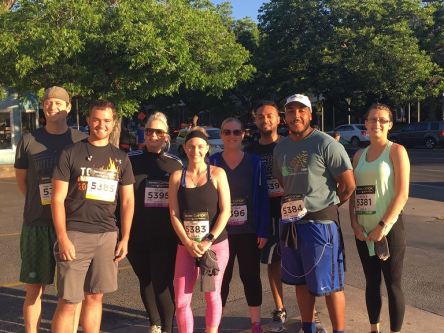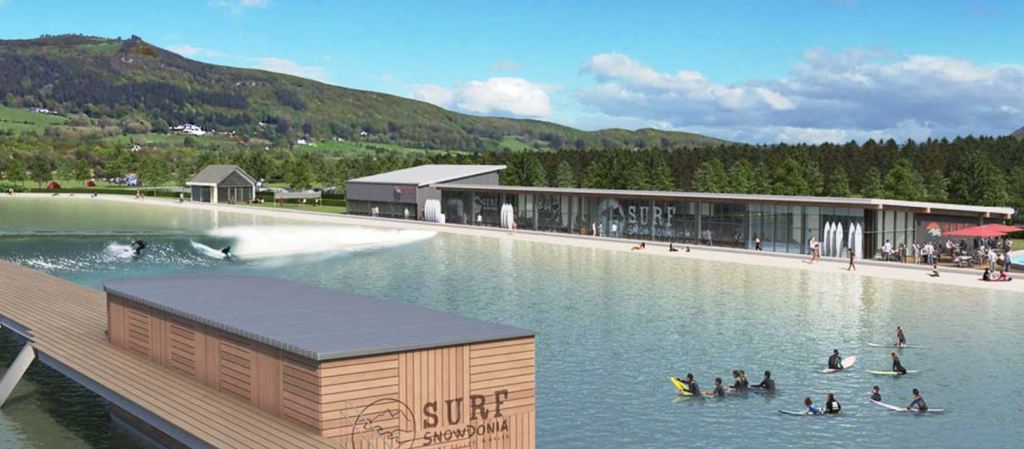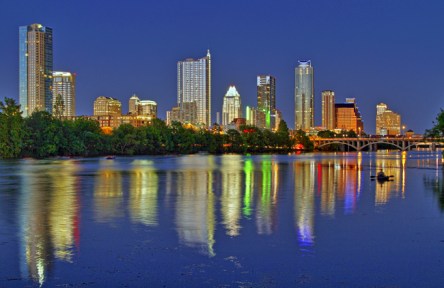When it comes to celebrating the importance of parks, there is no better place to gather than a local park on a balmy spring day. Ideal weather helped to make Vic Mathias Shores Park the perfect backdrop for the 2017 Austin Cap 10K, a benefit race for local nonprofits. The Austin Cap 10K race winds 6.2 miles through the city and is accompanied by a two-day health and fitness expo. Participants are encouraged to come dressed as their favorite superhero or sport t-shirts from their favorite business or organization. Several Yardi Austin team members participated in the race including Dan Woodhead, Joshua Dwyer, Kelly Wolf, Ann Vejsa, Will Manns, Daniel Cook, Nicole Benavidez, Ashley Musso, and Robyn Chavez. Chavez, a five-time race participant, describes the morning of the event. “The weather was perfect! I was a little nervous but overall excited. There were more than 20,000 people who ran it this year and the crowd was amazing!” Participants are encouraged to walk, jog, or run the course. The race leads registrants through several popular landmarks in the city, which makes for terrific sightseeing at a slower pace. There are just enough hills to make the race a fun challenge for experienced runners. “I like to stay active as much as possible,” says Chavez. “Since I’ve done this race in the past, I like to continue with my yearly tradition and try to beat my time from the previous year.” Chaves beat last year’s time by two minutes. Post-race events take place at Vic Mathias Shores Main Lawn overlooking the Lady Bird Lake waterfront. Participants receive massages, free prizes and swag from vendors. Food trucks, live music, and interactive exhibits create a festive atmosphere for hours after the race has ended. What makes the Austin...
Making Waves
Man Made Surf Comes Austin's Way
Until recently, surfing has been an activity limited to the lucky ones with oceanfront access. This is about to change with some incredible technology created by Spanish engineering firm Wavegarden, which has the capability to deliver the longest man-made surfable waves on Earth. Sounds surreal, doesn’t it? Doug Coors, a descendent of the Coors Brewing family, made it his mission to put Austin, Texas on the surfer’s map by bringing the ocean-bound sport inland. The self-proclaimed engineer and surfer, founder and CEO of NLand Surf Park, LLC said it took him 15 years to find the proper technology to mimic an actual surf break. He found it in Spain and decided to bring it to North America. Coors plans to raise these waves for the public starting next year. Why Austin? Austin has become a powerful magnet for investors and tourists, a weekend heaven for festivals and activities of all kinds – from SXSW to triathlons for the disabled, biker rallies, and Eeyore’s Birthday Party. Sports lovers and creative entrepreneurs have made Austin their home partly due to the willingness to give new ventures a chance, no matter how ambitious they are. Probably the best example to sustain this perspective is the recently completed Circuit of The Americas Formula 1 track, the first in the country to be built specifically for F1 races. Interesting is that it is located down the road from the proposed NLand Surf Park site. The lagoon will be located east of Austin-Bergstrom International Airport on rural property as big as nine football fields. The complex will offer 11 different surfing areas, with four different surfing levels, designed to create every 60 seconds perfect waves ranging between one to six feet high, with a surfing experience of 35 seconds per wave; think 300 distinct waves per hour. The technology behind the massive lagoon has been created in collaboration with the team and tech at Wavegarden in Spain, who proved its capabilities through the thousands of waves it has pumped in the Basque Country wave park. One of the most intriguing and fascinating facts about NLand Surf Park is the claim that, after the initial fill, the park will be self-sustaining with rainwater, even during tough drought conditions. Imagine surfing on raindrops. “Our top priority is water and water conservation,” Coors told Think Progress. “The surf community is very environmentally conscientious and they pride themselves on environmental stewardship. We want to fit in with that as much as possible.” With the water consumption solved, energy use comes next. Water is heavy and moving it needs energy; the ocean has the sun and the wind to create the waves, how will this massive project be fueled? Even though Wavegarden’s CEO Josema Odriozola said that the energy consumption in the company’s technology is much lower compared with the other existing wave generation technologies, the matter is a hot subject. One solution would be to make the park use solar power by placing panels on the unused land; however, this part of the project has not been nailed down yet. Coors has been discussing with three solar providers to determine the possibilities. Austin-based White Construction Company was chosen to execute the project within eight months with approximately 90 construction craftsmen and professionals on site. The undertaking is privately funded. Backing for the project is provided by 9th Street Capital, a Colorado-based private equity firm where Coors is president. Opinions on the project are diverse, ranging from excitement to anger, but the project will happen. NLand Surf Park will be just like an indoor rock climbing gyms – perfect for training. Sounds like it will be a destination for all the surfers who have relocated in Austin, until they make it back to Mother Nature’s...
High Speed Chase
Austin fiber showdown
Austin, Texas is already famous. It is home to the major multimedia festival South by Southwest, a great music and arts scene, and fabulous queso. And now that Google and AT&T have decided to go head-to-head to deliver Austin super-duper fast Internet connectivity, it might be time to change the slogan “Keep Austin Weird” to “Keep Austin Wired.” This week, AT&T announced that Austin will be the next city to benefit from the wonders of Google Fiber, which offers online access at speeds 100 times faster than what most of us are used to. How fast is one gigabit per second? Fast enough that you could download a 2GB file in a few seconds, rather than a few hours. Kansas City was the first market to feel the magic. Fiber was rolled out there in late 2012, prompting the growth of new businesses, much media attention, and happy/lucky Internet users. Google’s statement on why Austin was chosen for Fiber: “It’s a mecca for creativity and entrepreneurialism, with thriving artistic and tech communities, as well as the University of Texas and its new medical research hospital,” said Milo Medin, VP of access services for Google Fiber, on Google’s blog. “We’re sure these folks will do amazing things with gigabit access, and we feel very privileged to have been welcomed to their community.” Google plans to be live with Fiber in Austin by summer 2014. The very same day Austin’s selection as the next Fiber city was announced; AT&T announced it would bring its Project VIP effort to Austin, too. Project VIP is a broadband expansion effort, supported by advanced fiber optic infrastructure, that also promises speeds of 1 GBPS. The nationwide effort entails AT&T spending $14 billion over the next three years to enhance its...



